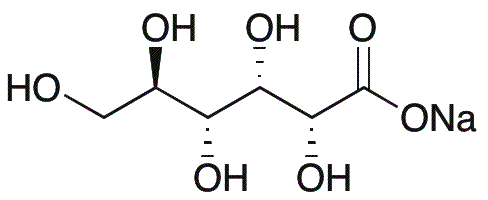Sodium gluconate is widely utilized in research focused on:
- Food Industry: It acts as a food additive and preservative, enhancing the shelf life and stability of products like sauces and dressings.
- Pharmaceuticals: Used as a stabilizer in drug formulations, it helps improve solubility and bioavailability of active ingredients.
- Cosmetics: Commonly found in skincare products, it serves as a humectant, attracting moisture to the skin and improving texture.
- Construction: In concrete formulations, it functions as a plasticizer, improving workability and reducing water content for stronger structures.
- Cleaning Products: It acts as a chelating agent, effectively binding metal ions to enhance the performance of detergents and cleaners.
General Information
Properties
Safety and Regulations
Applications
Sodium gluconate is widely utilized in research focused on:
- Food Industry: It acts as a food additive and preservative, enhancing the shelf life and stability of products like sauces and dressings.
- Pharmaceuticals: Used as a stabilizer in drug formulations, it helps improve solubility and bioavailability of active ingredients.
- Cosmetics: Commonly found in skincare products, it serves as a humectant, attracting moisture to the skin and improving texture.
- Construction: In concrete formulations, it functions as a plasticizer, improving workability and reducing water content for stronger structures.
- Cleaning Products: It acts as a chelating agent, effectively binding metal ions to enhance the performance of detergents and cleaners.
Documents
Safety Data Sheets (SDS)
The SDS provides comprehensive safety information on handling, storage, and disposal of the product.
Product Specification (PS)
The PS provides a comprehensive breakdown of the product’s properties, including chemical composition, physical state, purity, and storage requirements. It also details acceptable quality ranges and the product's intended applications.
Certificates of Analysis (COA)
Search for Certificates of Analysis (COA) by entering the products Lot Number. Lot and Batch Numbers can be found on a product’s label following the words ‘Lot’ or ‘Batch’.
*Catalog Number
*Lot Number
Certificates Of Origin (COO)
This COO confirms the country where the product was manufactured, and also details the materials and components used in it and whether it is derived from natural, synthetic, or other specific sources. This certificate may be required for customs, trade, and regulatory compliance.
*Catalog Number
*Lot Number
Safety Data Sheets (SDS)
The SDS provides comprehensive safety information on handling, storage, and disposal of the product.
DownloadProduct Specification (PS)
The PS provides a comprehensive breakdown of the product’s properties, including chemical composition, physical state, purity, and storage requirements. It also details acceptable quality ranges and the product's intended applications.
DownloadCertificates of Analysis (COA)
Search for Certificates of Analysis (COA) by entering the products Lot Number. Lot and Batch Numbers can be found on a product’s label following the words ‘Lot’ or ‘Batch’.
*Catalog Number
*Lot Number
Certificates Of Origin (COO)
This COO confirms the country where the product was manufactured, and also details the materials and components used in it and whether it is derived from natural, synthetic, or other specific sources. This certificate may be required for customs, trade, and regulatory compliance.

